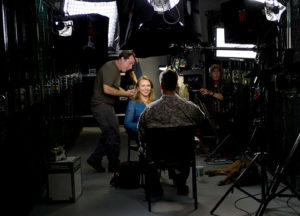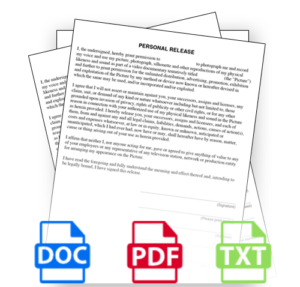Looking for documentary release forms? We’ve got you covered. From personal release forms for documentary interviewees to archival materials release forms, we’ve got all your documentary form needs covered. You can modify this documentary interview release form template to suit your needs and add your own film title, logo, or special clauses as needed.
Documentary film release form kit:
- Documentary Interview Release Form
- Release Form For Minors
- Archival Materials Release Form
- Sample Release Signage For Events
- Legalease Explainer “Cheat Sheet”
- Bonus: 25 Kickass Interview Questions
Why are documentary film release forms necessary?
 Documentary film release forms are extremely important because they establish a binding agreement between you (the documentary filmmaker or producer) and the people you interview as part of your documentary film. Documentary film release forms provide you with proof that you got permission to film an interview or shoot other footage of your documentary subjects and that you own the rights to the footage– to be used as you wish. Lawsuits are very uncommon but documentary forms do become especially important when you want to distribute your film– let’s say PBS wants to air it, but they require you to have signed release forms from all the recognizable participants in your film.
Documentary film release forms are extremely important because they establish a binding agreement between you (the documentary filmmaker or producer) and the people you interview as part of your documentary film. Documentary film release forms provide you with proof that you got permission to film an interview or shoot other footage of your documentary subjects and that you own the rights to the footage– to be used as you wish. Lawsuits are very uncommon but documentary forms do become especially important when you want to distribute your film– let’s say PBS wants to air it, but they require you to have signed release forms from all the recognizable participants in your film.
Additionally, documentary film release forms establish how you as the filmmaker can use your footage, and also whether or not the subject is getting compensated for their appearance in your film.
Who needs to sign a documentary film consent form?
 Different film distributors and broadcasters have different release form or documentary waiver requirements. Generally speaking, you will want to get a release form from anyone who speaks on camera and is recognizable in your film– with the possible exception of public officials speaking at events for instance, or in some cases people on the public streets who have no expectation of privacy (such as protestors at a rally or demonstration).
Different film distributors and broadcasters have different release form or documentary waiver requirements. Generally speaking, you will want to get a release form from anyone who speaks on camera and is recognizable in your film– with the possible exception of public officials speaking at events for instance, or in some cases people on the public streets who have no expectation of privacy (such as protestors at a rally or demonstration).
In some rare cases television broadcasters may require you to blur the faces of people without release forms that you can’t edit around, or blur the faces of minors that you don’t have release forms for (in the US for instance individuals under age 18 aren’t considered adults so their parents or guardians need to sign special release forms on their behalf). Overall, we’d argue that it’s always better to be safe than sorry when it comes to getting signed release forms. And that any release form a person signs is better than no release form at all.
Overall for most documentary film purposes, you’ll need to get your main documentary film subjects to sign a release form as well as the other people who appear in and speak in your footage, as long as they aren’t in public.
What are the different types of documentary forms?
Documentary forms come in several different flavors. Below we’ll explain each form and what it’s purpose is. Not all films will need all forms.
| Documentary Interview Release Form | This is the most common type of release form that documentary filmmakers use. Everyone that you interview in your film should have a signed Interviewee Release Form, also sometimes called a Personal Release Form. Even if you don’t technically do a sit down interviewee with someone in your film, most of the time you still need a release form from them if they’re featured in your footage. |
|---|---|
| Release Form For Minors | In the US, people under the age of 18 aren’t considered adults so they can’t sign legal documents. If you have minors in your footage, you’ll need to get their parents or guardians to sign this special release form on their behalf. |
| Archival Materials Release Form/Property Release Form | If your documentary subject gives you permission to use an old photograph or home movie of theirs some film distributors and broadcasters may need them to sign an archival release form too. Sometimes this is referred to as a Property Release Form or simply a Materials Release. |
| Release Signage for Events | Depending on your documentary film subject, you may find yourself filming at public events where you have permission from the people holding the event to film, but you won’t have the opportunity to get a release form from everyone present. In those cases a release form sign can be useful. You can place this sign at the entrance (or entrances) to the event so people see it when they walk in. Make sure to get footage of the sign at the event so you can prove you had one posted in case you ever need to. |
Documentary release form tips
Some filmmakers feel awkward or get nervous about asking their subjects to sign release forms, especially if they suspect their film subjects will be nervous about signing anything with “legalese.” Here are some tips to help make getting your documentary film release forms signed less awkward:
- Let your subjects know in advance that you will have a form for them to fill out– don’t just spring it on them at the last minute. Knowing to expect a release form in advance prevents a lot of awkward surprises.
- In some cases your subjects might feel more comfortable signing what you introduce as a “permission slip” or a “waiver” instead of a “legal release form.”
- Let your interviewee know that you can answer questions they might have about the release form they’re signing (our release forms include an annotated guide that explains each provision in simple english– what it means and why it’s in there, so you can explain to anyone who asks you).
In general, it’s important for documentary filmmakers to keep in mind that regular people understand that they may have to sign a waiver or filming release form. This is not strange, it is not out of the ordinary, and for many people it will be expected. Tell your subjects that you will have a standard release form for them to sign ahead of time and you will almost never run into problems.
In situations where you are getting vox pops or “man on the street” interviews, some filmmakers rely on the fact that the individuals being filmed are in a public place and thus, legally, have no expectation of privacy (depending on local laws this may differ). However ideally we recommend at the very least you get the person you’re talking to to say and spell their full legal name (and email address or phone number if they have one) and agree that they know they’re being filmed. You won’t use this footage of course, but you’ll have it in the can which might help you get cheaper E&O insurance for broadcast. E&O is short for Errors & Omissions insurance that some broadcasters may require you to have before accepting your film for television broadcast.
Download documentary release forms
Important Disclaimer
Some documentary films may need special language added to their release forms depending on their subject matter (and some broadcasters or film distributors may have their own in-house forms that they want you to use). We’re not responsible for any legal issues arising out of the use of the sample release forms that we provide as a reference. Although forms like these have been used in tons of documentaries without problems, you should always consult with an entertainment lawyer before putting these documents to use.

